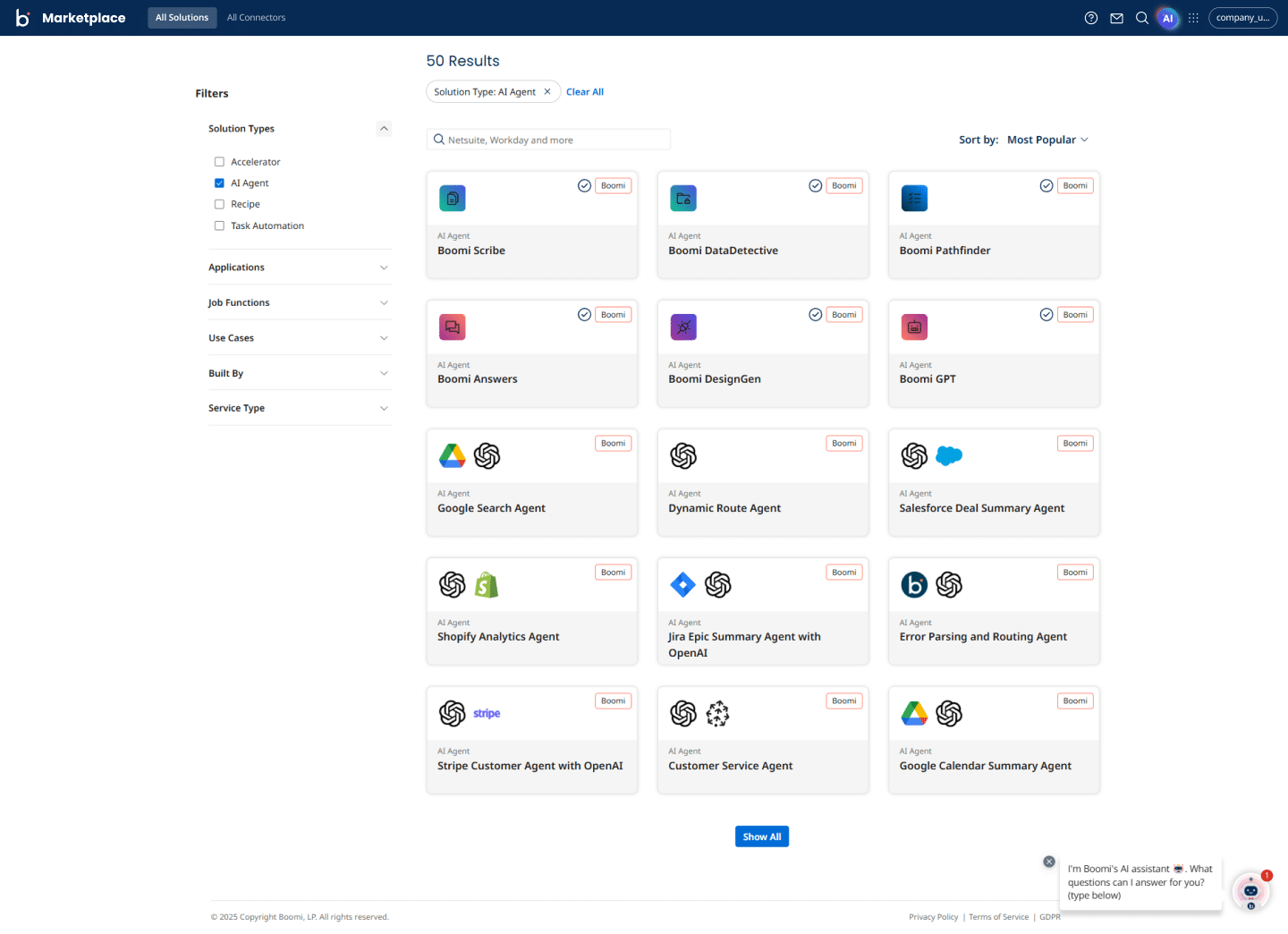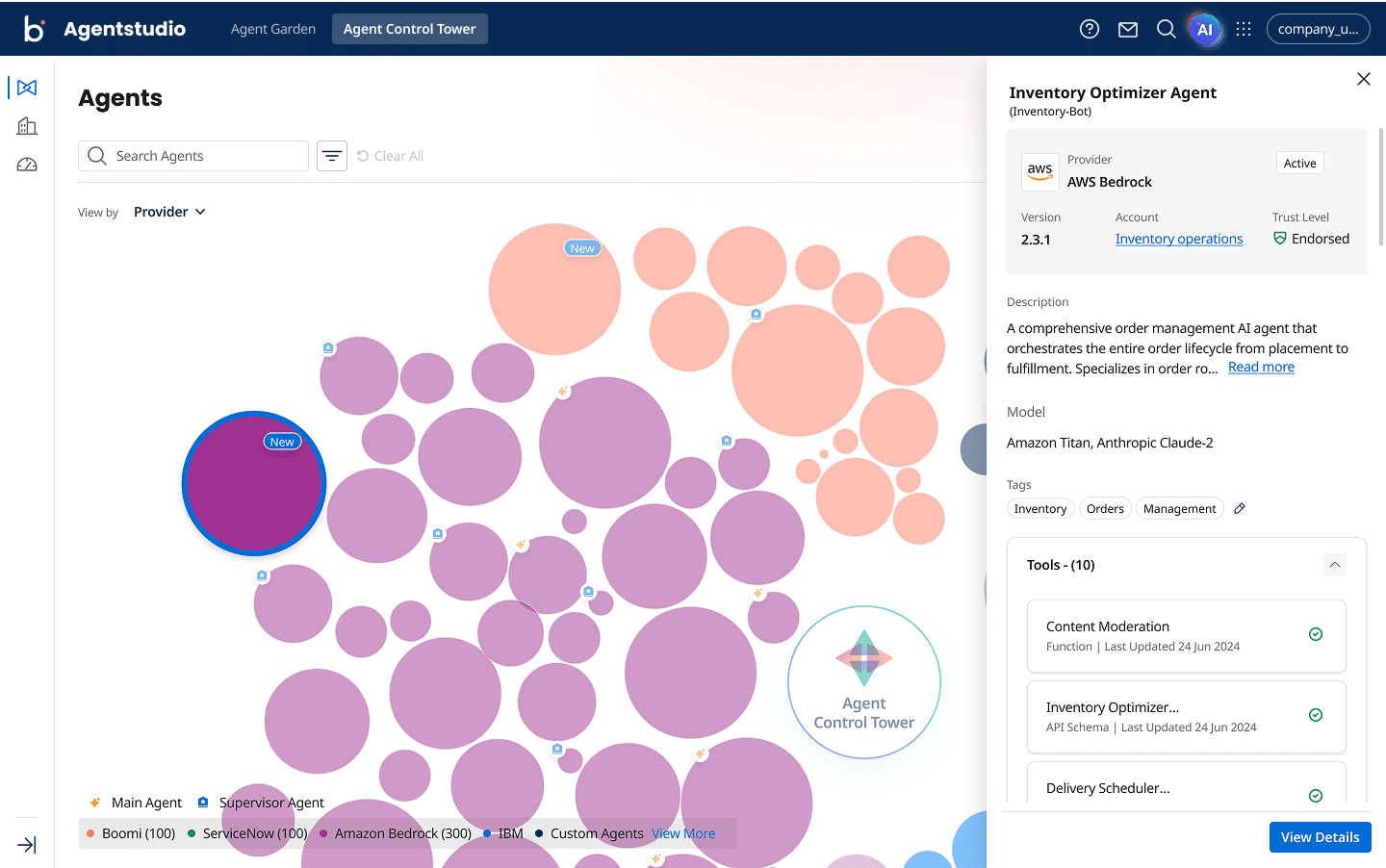In his recently published book Digital Impact, Boomi CEO Steve Lucas declares, “We’re at the dawn of ‘The Agent Economy’ in the same way the iPhone led to ‘The App Economy.’” He goes on to note that when the Apple App Store opened, it had 500 applications. Now? Nearly two million.
The Agent Economy is likely to explode in similar fashion. And Boomi can help you prepare.
As organizations embrace artificial intelligence (AI) for all its benefits, they often deploy multiple AI agents across various departments and functions, sometimes even using different providers. Unmanaged, this proliferation will create “agent sprawl” — the uncontrolled growth and deployment of agents, which can undermine the effectiveness of AI initiatives as well as organizational integrity.
Understanding the Risks of Agent Sprawl
Without proper oversight and management, organizations face several, most likely unplanned, risks. These include:
- Security Vulnerabilities: Unmanaged AI agents are ideal entry points for cyber threats, leading to data breaches and unauthorized access to sensitive information.
- Compliance Challenges: Regulations surrounding data privacy and AI are bound to become more stringent. Organizations must ensure all deployed agents adhere to legal and ethical standards.
- Operational Inefficiencies: Without a centralized AI agent management system, redundancy, conflicting functionalities, and wasted resources will ultimately hinder productivity.
- Loss of Control: With numerous agents operating independently, maintaining visibility and control over the AI ecosystem is difficult, making it difficult to assess performance and mitigate risks.
Boomi Agentstudio Delivers Centralized AI Agent Management
Understanding and addressing the risks associated with agent sprawl are crucial for organizations looking to leverage AI agents effectively. That’s why we’re excited to announce the general availability of Boomi Agentstudio. This full agent lifecycle management solution empowers organizations to simply design, govern, and orchestrate AI agents at scale to unlock hyperproductivity responsibly.
Watch the video overview of Agentstudio:
Where Autonomy Meets Responsibility
Boomi Agentstudio is reshaping how developers approach AI agent management by prioritizing responsible AI principles across the entire agent lifecycle. We believe organizations should never have to choose between governance and innovation, autonomy and oversight, speed and safety, or democratization and security. To combat what our CEO, Steve Lucas, refers to as “AI agent mischief,” we provide universal governance capabilities to ensure every agent — whether developed in-house, sourced from a marketplace, or delivered by a trusted partner or consultancy — stays compliant.
Boomi Agentstudio contains four key components that help you unlock hyperproductivity responsibility.
Agent Garden
The Agent Garden serves as a unified space for AI agent design, testing, deployment, and tool development. Here, users can interact with deployed AI agents using natural language. Think of it as the central hub, where you cultivate your agent collection and manage the tools they need to thrive.

Agent Designer
The Agent Designer component lets users design custom AI agents using pre-built templates and AI assistance. During the development phase, we equip developers with powerful tools they already know from the Boomi Enterprise Platform, including integrations, APIs, and data, to fuel agents and give them the access they need to take meaningful action. With built-in guardrails, developers can set safety controls that limit what an AI agent can say or do, reinforcing our commitment to responsible AI. Once deployed, these agents can be integrated into any workflow inside Boomi Integration, unlocking entirely new levels of hyperproductivity.

Agent Marketplace
If you are new to the world of AI agents or looking for inspiration on use cases, Agent Marketplace is your one-stop shop for proven, customizable AI agents from Boomi and our trusted partners. These off-the-shelf solutions are designed to integrate seamlessly into a wide range of workflows, helping you get started faster and drive impact sooner.

Agent Control Tower
Despite being critical to AI success, too often, governance is treated as an afterthought, only addressed when something goes wrong. Agent Control Tower provides a centralized registry for governing and monitoring AI agents from Boomi as well as third-party sources. This allows organizations to oversee agent performance with built-in observability, detect anomalies, and reduce security and compliance risks.

The Time to Take AI Agent Control Is Now
As AI adoption grows, so too will the risks of agent sprawl. Most organizations probably don’t have agent sprawl — yet. But if ever there was cause for “the ounce of prevention” approach, it’s agent sprawl. The chance to minimize the complexity that will inevitably be introduced by agent sprawl is reason enough, let alone avoiding a bevy of compliance and data security risks.
Senior executives, from CIOs, CTOs, and chief artificial intelligence officers (CAIOs) to heads of integration, AI, and enterprise architecture, all have “skin in the game” when it comes to preventing agent sprawl. These leaders face shared challenges such as governance, security, integration, and talent gaps. Boomi Agentstudio offers the trusted solutions they need to address agent sprawl with universal governance and drive successful AI initiatives.
An Interoperability Hub for the Future
AI is radically improving workflow automation at record speed. To keep up, your infrastructure needs to support, manage, and govern the dynamic, process-aware agents that will drive business forward.
More than 23,000 customers put their trust in the Boomi Enterprise Platform, which brings together integration, automation, data, APIs, and AI. As of today, there are more than 39,000 active deployments of Boomi AI Agents, and that number is growing by the day.
We envision Boomi Agentstudio as the interoperability hub, orchestrating AI agents through open standards, including model context protocol (MCP) and agent-to-agent communication, to fuel agentic transformation and power a fully connected, high-performing business.
Learn how to design, govern, and orchestrate AI agents today with Boomi Agentstudio.
